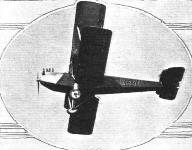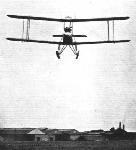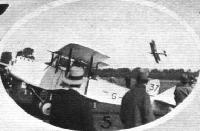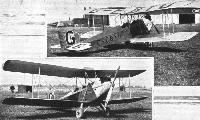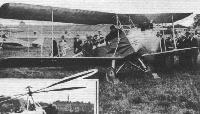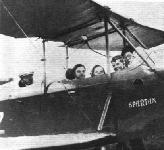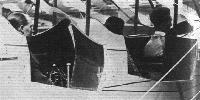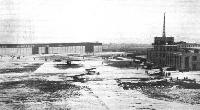
Варианты
- Simmonds - Spartan - 1928 - Великобритания
- Spartan - Arrow - 1930 - Великобритания
Spartan (Великобритания). Самолеты ранних типов
На заводе в Хэмпшире, Южная Англия, Оливер Симмондз спроектировал и построил в 1928 году прототип двухместного биплана Simmonds Spartan с мотором Cirrus III мощностью 95 л.с. Всего построили примерно 50 таких самолетов, почти половину из которых продали за пределы Великобритании. На самолеты ставили различные моторы мощностью от 80 до 120 л. с.
Самолеты выпускались компанией "Simmonds Aircraft Ltd", но успех Spartan привел к тому, что в 1930 году реорганизованная фирма получила название "Spartan Aircraft Ltd".
<...>
Описание:
- Spartan (Великобритания). Самолеты ранних типов
- Spartan (Великобритания). Самолеты
- Flight, September 1928
SIMMONDS' "SPARTAN” - Flight, July 1929
BRITISH AIRCRAFT AT OLYMPIA - Flight, April 1930
AIRCRAFT FOR THE PRIVATE OWNER - Flight, November 1932
British Aircraft
Фотографии
-
Flight 1929-01 / Flight Advertisements
Регистрационный номер: G-EBYU [7] -
Flight 1929-02 / Flight Advertisements
Регистрационный номер: G-EBYU [7] -
Flight 1930-01 / Flight
Регистрационный номер: G-EBYU [7] Well-known modern light 'plane: Simmonds "Spartan."
-
Flight 1928-09 / Flight
Регистрационный номер: G-EBYU [7] The Simmonds' "Spartan" in low flight over Croydon Aerodrome on September 3, when it was demonstrated by Mr. O. E. Simmonds and Capt. N. Stack.
-
Flight 1929-07 / Flight
ONE AVIATES AT BRISTOL: Mr. Bartlett is here seen flying two machines (but not at the same time). When the Bristol Club's "Moth" got a little tired, the Simmonds "Cirrus-Spartan".
-
Flight 1929-07 / Flight
Регистрационный номер: G-AAMC [2] SIMMONDS 2-SEATER "SPARTAN" ("Cirrus III").
-
Flight 1932-01 / Flight
Регистрационный номер: G-ABRA THE "SPARTAN CIRCUS" IN AFRICA: "Snap" from the Cape taken on the occasion when the Circus (which is composed of Mr. Oscar Garden, Capts. E. D. Ayre, J. King, E. D. Cummings, Mr. John Tranum and Mr. C. E. F. Reilly) now touring Africa, visited the Cape Town Airport. One of the three "Hermes-Spartans" belonging to the Circus.
-
Flight 1932-01 / Flight
Регистрационный номер: G-ABRB THE "SPARTAN CIRCUS" IN AFRICA: "Snap" from the Cape taken on the occasion when the Circus (which is composed of Mr. Oscar Garden, Capts. E. D. Ayre, J. King, E. D. Cummings, Mr. John Tranum and Mr. C. E. F. Reilly) now touring Africa, visited the Cape Town Airport. The picture shows John Tranum, with revolver, as aerial cowboy astride the "Spartan."
-
Flight 1928-09 / Flight
This front view of the "Spartan" light 'plane in flight shows in particular the split axle.
-
Flight 1930-11 / Flight
Регистрационный номер: G-ABAZ [2] A Spartan 3-seater (Gipsy II) flying over Southampton Water.
-
Flight 1929-07 / Flight
SOME OTHER COMPETITORS: (5) Flight-Lieut. C. S. Staniland, on the Simmonds "Spartan" (in the air), who was "missing" after leaving Blackpool. J. D. Irving's "Gipsy Moth" in the foreground.
Другие самолёты на фотографии: De Havilland Gipsy Moth / Moth X - Великобритания - 1928
-
Flight 1929-07 / Flight
SOME OTHER COMPETITORS: (1) F./O. R. W. Jackson, on J. Parkinson's Simmonds "Spartan" ("Cirrus III").
-
Flight 1931-07 / Flight
THE SPARTAN: In the race are entered two with Hermes II and two with Cirrus III engines.
-
Flight 1929-07 / Flight
FIRST DELIVERY. A Simmonds "Spartan" (85 h.p. "Cirrus III") light 'plane, the first to be delivered to National Flying Services, Ltd. It is painted in the N.F.S. colours of orange and black.
-
Flight 1929-04 / Flight
Capt. N. Stack, the A.D.C. Aircraft test pilot, taking off in Mr. Mase's Cirrus-Spartan at Croydon to give an exhibition flight. The building behind is the Aerodrome Hotel.
-
Flight 1928-09 / Flight
Регистрационный номер: G-EBYU [7] Two views of Simmonds "Spartan" ("Cirrus" Mk. III) fitted with Fairey metal airscrew, which is distinctive for its interchangeability of wings, of rudder with elevators, and of fin with tail plane sections.
-
Flight 1931-07 / Flight
"FORTY MINUTES": Some of the Competitors - Nos. 21 (Widgeon III Genet II), 20 (D.H.Moth Gipsy I), 18 (Widgeon III Gipsy I) and 14 (Spartan Hermes II) - refuelling at Heston on the first lap.
Другие самолёты на фотографии: De Havilland Gipsy Moth / Moth X - Великобритания - 1928Westland Widgeon - Великобритания - 1924
-
Flight 1932-05 / Flight
The start of the first heat for the Race at Skegness: (Left to right) "Avian," "Cadet," "Avian," "Spartan," "Widgeon" and Autogiro - the last, in its first race.
Другие самолёты на фотографии: Avro Avian / Type 594/616 - Великобритания - 1926Avro Cadet / Type 631/643 - Великобритания - 1932Cierva/Avro C.19 - Великобритания - 1929Westland Widgeon - Великобритания - 1924
-
Air-Britain Archive 1984-04
Регистрационный номер: G-AAMC [2] Simmonds Spartan G-AAMC which survived for only one month with NFS before its demise at Hanworth on 28.7.29.
-
Aeroplane Monthly 1989-01 / Personal album. Civil
Регистрационный номер: G-ABAZ [2] Spartan Three Seater I G-ABAZ, built in 1930 and powered by a Gipsy II engine. Numbered 25 in that year's King's Cup race, it was flown into 21st place by J. F. X. McKenna. For much of its pre-war life AZ was flown by Sandown and Shanklin Flying Services. After the war the marks were cancelled but the airframe is believed to survive north of Watford.
-
Flight 1931-07 / Flight
Регистрационный номер: G-AAHA FIRST ARRIVAL AT HOOTON: Flt.-Lt. Gibbons has his Spartan (Hermes II) refuelled. He was away again before one-half of his competitors arrived from Sherburn.
-
Flight 1928-07 / Flight
The Simmonds "Spartan" is unusual, in that the wings are so designated that the same spare wing can be used on either side and as top or bottom plane.
-
Flight 1929-01 / Flight
Lieut.-Col. L. A. Strange, D.S.O., M.C., D.F.C. (right) and Mr. H.W.R Banting, at the Tempelhof aerodrome. Berlin, with the Cirrus-Spartan in which they flew non-stop from London in 7 hrs. 10 mins. and back in 6 hrs.
-
Flight 1928-09 / Flight
Mr. O. E. Simmonds, the designer of the Simmonds' Spartan ("Cirrus" Mk. III), who is also a qualified pilot.
-
Flight 1929-04 / Flight
Mr. Frank Mase introducing Lady Bailey before the ceremony in a brief speech which praised Lady Bailey's aviation accomplishments.
-
Flight 1929-07 / Flight
A SPARTAN GROUP: (left to right) Mr. C. Cook, Mr. Fred Simmonds, Mr. C. Staniland, the Simmonds test pilot (in the cockpit), and Miss V. Withers.
-
Flight 1929-04 / Flight
Регистрационный номер: G-EBYU [7] The Simmonds "Spartan" Light 'Plane, "Cirrus" Engine.
-
Flight 1928-12 / Flight
Регистрационный номер: G-EBYU [7] SIR ALAN COBHAM TRIES A NEW MOUNT: Sir Alan Cobham gave a fine exhibition of skilful piloting on the Simmonds "Cirrus-Spartan" at Croydon on December 11, in a high and very gusty wind. Sir Alan expressed himself as delighted with the airworthiness and "robust feeling" of the Spartan in the air
-
Aeroplane Monthly 1983-09 / P.Capon - Capon's Corner
Регистрационный номер: G-AAFR [2] G-AAFR shortly before its crash.
-
Air-Britain Archive 1981-03
Регистрационный номер: ZK-ABZ ZK-ABZ displayed in New Zealand Airways dark blue and silver colour scheme at Christchurch 10.9.78.
-
Flight 1929-07 / Flight Advertisements
Cellon Dope meets all requirements - it is used for Service Machines, Civil Air Lines and light Aeroplanes, a fine example of which is shown here. "Spartans," built by Simmonds Aircraft, Ltd., are used in many foreign countries, and they are always, of course, doped with CELLON, which gives unvarying satisfaction under the most varying conditions.
-
Flight 1930-04 / Flight
SIMMONDS 3-SEATER "SPARTAN." ( A.D.C. "Hermes.")
-
Flight 1932-08 / Flight
A WINNER AT SKEGNESS: Lt. Col. L. A. Strange about to take off in the new "Spartan II" (Hermes II B).
-
Flight 1932-09 / Flight
Регистрационный номер: G-ABTR [4] Three-seater "Spartan" ("Hermes IIB") of Lt. Col. L. Strange. A trinity which won the Isle of Thanet Cup.
-
Flight 1932-06 / Flight
Регистрационный номер: G-ABTR [4] A new version of that excellent aircraft for joy-riding - the Spartan 3-seater - which was seen at Heston during Henly's Rally on Saturday, June 4.
-
Flight 1929-07 / Flight
The Simmonds Stand: "Spartan" two-seaters and three-seaters are shown. The coupe could not be got ready in time for the Show.
-
Flight 1929-09 / Flight
The new long-span Simmonds Spartan with the new car-type engine cowling.
-
Flight 1931-07 / Flight
FIRST IN FIRST ROUND: Fl.-Lt. Gibbons (Spartan), the first back at Heston on the first round of the King's Cup.
-
Aeroplane Monthly 2000-07
John Havers knows that this Spartan is at Cdr Tomlinson’s landing ground at the Old Barn Tea House, Hildenborough, Kent. The man in the peaked cap is the car park attendant, but who are the pair in flying helmets?
-
Flight 1932-05 / Flight
The winning "Spartan" 3-seater landing at Skegness after its excellent race.
-
Flight 1933-11 / Flight
FROM SOUTH AFRICA: The three-seater Spartan ("Hermes II"), with Messrs. Duk and Store aboard, of Aero Services (Pty.), Ltd., Wynberg, South Africa. This machine was originally taken out to South Africa by Mr. John Tranum, and after a period of hard work was sold to its present owners, who have since had consistent and good service from it.
-
Flight 1933-07 / Flight
ONLY A "SPARTAN" WOULD ATTACK THE "HEYFORD": With a gunner above and a gunner below, in a rotatable turret, the new Handley Page night bomber is well defended. On this occasion the "Heyford" was piloted by Sqd. Ldr. T. England and the "Spartan" by Capt. Cordes.
Другие самолёты на фотографии: Handley Page Heyford / H.P.38 / H.P.50 - Великобритания - 1930
-
Flight 1932-10 / Flight
Landing the Hermes II "Spartan" for operation with the East Greenland Air Survey.
-
Flight 1929-01 / Flight
CHRISTENING CEREMONY OF SIMMONDS "SPARTAN" PRODUCTION TYPE: In the picture on the left is Mr. O. E. Simmonds, Chairman (left), and his co-director, Lt.-Col. L. A. Strange, D.S.O., M.C., D.F.C. On the right, The Mayor and Mayoress of Southampton (Mr. and Mrs. Pugh) are trying the comfortable and spacious cockpits of the Simmonds "Spartan" (A.D.C. "Cirrus" Mk. III), Mr. Simmonds being alongside. Below is the Mayoress about to perform the christening ceremony in the usual way in the Company's Woolston works, on December 31, when a large number of guests were present.
-
Flight 1929-04 / Flight
The Hon. Lady Bailey christening the Simmonds "Cirrus-Spartan" light 'plane "The All Black" at Croydon Aerodrome on April 19. In this machine Mr. Frank Mase will attempt a solo flight to New Zealand shortly.
-
Flight 1930-07 / Flight
Mr. Andrews' "Spartan" (Gipsy II), No. 24, had a neat engine cowling, the passenger's cockpit covered over, the pilot s fairing raised, and a very small windscreen (106-32 m.p.h.)
-
Flight 1930-05 / Flight
A SPARTAN SPARTAN: The first Spartan to be fitted with skis, in Norway.
-
Flight 1934-04 / Flight
A SPARTAN IN SWEDEN: This Spartan ("Hermes II") is used by Wideroe's Flyveselskap of Oslo for flights up to the mountains. It is shown fitted with skis, and Lt. A. Wideroe is seen attending to the skis for his own undercarriage.
-
Flight 1932-03 / Flight
Регистрационный номер: VQ-FAA FROM FIJI: A Spartan (Hermes II) seaplane which Mr. Gordon Fenton has operated in the Fiji Islands for over 500 hours without any untoward events.
-
Flight 1930-09 / Flight
FULL MEASURE: Col. Strange with an enthusiastic load in his 3-seater Spartan.
-
Flight 1933-08 / Flight
The first passengers taken up at Cramlington were piloted by Miss Pauline Gower. She has worked with the Hospitals Air Pageant ever since the start in April. Dorothy Spicer, her ground engineer, is seen helping two passengers into their "Spartan" three-seater (Hermes II).
-
Flight 1929-08 / Flight
Spartan Ingenuity: The front cockpit of the three-seater Simmonds "Spartan" has a very clever seating arrangement whereby the front passenger may sit either facing forward or facing aft. The back-rest is hinged in such a way as to be capable of being swung upwards out of the way, as is also the middle windscreen. When the machine is used as a two-seater, a special cover is provided which covers the front part of the cockpit. If desired a slightly longer cover can be fitted, which completely covers the cockpit opening and may be used if the machine is flown solo.
-
Flight 1932-09 / Flight
Ample room for two persons is provided in the rear cockpit of this, the latest version, of the Spartan 3-seater.
-
Flight 1929-01 / Flight
In this general view of Croydon Aerodrome under wintry conditions are the many machines which brought their owners to greet Lady Bailey. They include Capt. G. de Havilland's Coupe-Moth, Mr. G. A. R. Malcolm's Gipsy-Moth and Lt.-Col. L. A. Strange's Simmonds "Spartan." Also in the picture, which was taken from a "D.H." Moth piloted by Capt. A. S. White, are the "Daily Mail" "Geraldine" (D.H.61) and Alpha-Avian.
Другие самолёты на фотографии: Avro Avian / Type 594/616 - Великобритания - 1926De Havilland Giant Moth / D.H.61 - Великобритания - 1927De Havilland Gipsy Moth / Moth X - Великобритания - 1928
-
Aeroplane Monthly 1983-09 / P.Capon - Capon's Corner
Регистрационный номер: G-AAFR [2] <...> Spartan G-AAFR after its crash at Bursledon on March 27, 1930.
-
Flight 1929-07 / Flight
The interplane strut fittings on the Simmonds "Spartan" are all of one type, and can be used in all the various positions.
-
Flight 1929-07 / Flight
The hinge on the top rear spar, jury strut and fittings on the "Spartan."
-
Flight 1929-07 / Flight
The "Spartan" elevator is operated from a lay shaft via external cranks and push-pull tube.
-
Flight 1929-07 / Flight
In the "Spartan" tail the outer ends of the tail plane are identical with the fin, and each elevator flap is interchangeable with the rudder.
-
Flight 1929-07 / Flight
Undercarriage leg attachment and wing locking pin arrangement on the Simmonds "Spartan." On the right, details of spar and rib construction.
-
Flight 1929-07 / Flight
Simmonds "Spartan" Cirrus III Engine
-
Flight 1929-07 / Flight
(3 Seater) Simmonds "Spartan" Cirrus III Engine
- Фотографии



